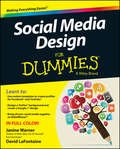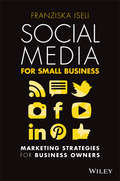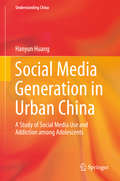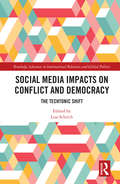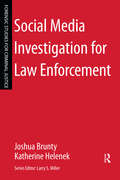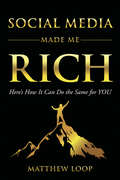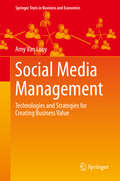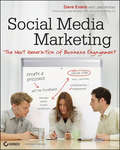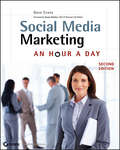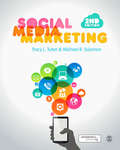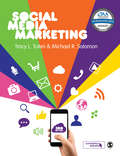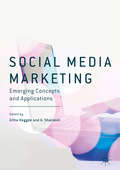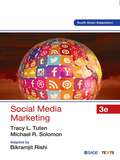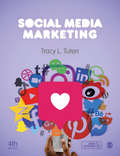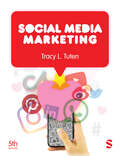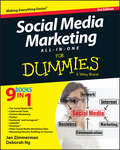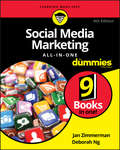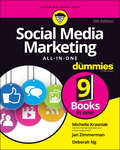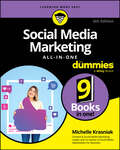- Table View
- List View
Social Media Design For Dummies
by Janine Warner David LafontaineLearn to design professional and effective social media profiles!Whether you're trying to attract a new employer or get new fans to notice your brand, your social media profiles need to distinguish you from the masses. Packed with the secrets behind the hottest Facebook timelines, Twitter backgrounds, and LinkedIn profiles, this fun-but-straightforward guide shows you how to create eye-catching social media profiles with a professional, cohesive design.Includes online resources and downloadable templates that allow you to make your own profiles quick and easyReveals techniques for making a memorable and unique Twitter background, Facebook profile and page, LinkedIn profile, Google+ profile, and moreDetails ways in which to use Pinterest boards and cover photos to showcase your brandShows you how to make the most of Rebelmouse and YouTube.Social Media Design For Dummies is a must-have introductory guide to creating a professional, effective, and cohesive design that will better communicate your brand's story to future partners, employers, and customers.
Social Media For Small Business: Marketing Strategies for Business Owners
by Franziska IseliDiscover how social media can transform your business and help you attract more customers Social Media For Small Business delivers a step-by-step guide to unlocking the potential of social media to grow your business. Award-winning author and entrepreneur Franziska Iseli walks you through how to use Facebook, LinkedIn, Instagram, YouTube, Twitter, and Pinterest to market your small-to medium-sized business. The book provides you with: Effective marketing strategies to get more out of your social media efforts. Systems to bring structure into your entire marketing approach. Tools to make your brand irresistible across your customer touchpoints. Case studies to highlight the application of the book’s principles to the real-world Practical strategies you can put in place immediately to see a rapid return on investment Perfect for busy business owners, business managers and marketing teams wanting to find new and effective marketing tools to attract more customers, Social Media For Small Business also belongs on the bookshelves of anyone who has difficulty with or wants to learn more about how social media can have a positive impact on their business and brand.
Social Media Generation in Urban China
by Hanyun HuangSocial media such as instant messaging (IM), social networking sites (SNS), blogs and microblogs are an integral part of adolescents' lives in China. Anecdotal evidence reported in the news has suggested that the increasing popularity of social media could make adolescents more vulnerable to being addicted. This exploratory study proposes the concept of "social media addiction" and examines (a) whether social media addiction exists among adolescents in urban China and, if so, who the addicts are, what their symptoms are and to what extent they are addicted; (b) whether sociopsychological traits (e. g. , need for affiliation, impression management, narcissism and leisure boredom) can predict social media addiction among adolescents; (c) what gratifications are obtained by adolescents from their use of social media and whether these gratifications can predict social media addiction and (d) to what degree social media addiction influences adolescents' academic performance and social capital. This study employed quantitative questionnaire surveys among adolescents as the main research method, supplemented by qualitative pre-survey focus groups among adolescents and post-survey in-depth interviews among parents and teachers. Questionnaire surveys were conducted based on a multi-stage cluster sampling of seven middle schools in five urban Chinese cities: Beijing, Shanghai, Guangzhou, Shenzhen and Xiamen. The final sample consisted of 1,549 adolescents, of whom 90% had used social media. Using Young's classic definition of Internet addiction, 15. 6% of participants were classified as social media addicts. The addicted adolescents were often self-absorbed, bored with their leisure time, and good at using manipulation through social media for impression management. Addicts experienced four major social media addiction symptoms: preoccupation, adverse consequences, alleviation of negative emotions and loss of interest in social activities. The seven social media gratifications identified in this study can be categorized into social, information and entertainment gratifications. Among these, entertainment gratifications had the most power to predict social media addiction, while information gratifications were the least likely to lead to addiction. Furthermore, these gratifications were found to be powerful mediators between the adolescents' sociopsychological traits and social media addiction. Finally, the results also indicated that social media addiction and its symptoms had a significant negative impact on adolescents' academic performance and social capital.
Social Media Impacts on Conflict and Democracy: The Techtonic Shift (Routledge Advances in International Relations and Global Politics)
by Lisa SchirchSocial media technology is having a dramatic impact on social and political dynamics around the world. The contributors to this book document and illustrate this "techtonic" shift on violent conflict and democratic processes. They present vivid examples and case studies from countries in Africa, South and Southeast Asia, Latin America as well as Northern Ireland. Each author maps an array of peacebuilding solutions to social media threats, including coordinated action by civil society, governments and tech companies to protect human minds, relationships and institutions. Solutions presented include inoculating society with a new digital literacy agenda, designing technology for positive social impacts, and regulating technology to prohibit the worst behaviours. A must-read both for political scientists and policymakers trying to understand the impact of social media, and media studies scholars looking for a global perspective.
Social Media Intelligence
by Wendy W. Moe David A. SchweidelIn the world of Facebook, Twitter and Yelp, water-cooler conversations with co-workers and backyard small talk with neighbors have moved from the physical world to the digital arena. In this new landscape, organizations ranging from Fortune 500 companies to government agencies to political campaigns continuously monitor online opinions in an effort to guide their actions. Are consumers satisfied with our product? How are our policies perceived? Do voters agree with our platform? Measuring online opinion is more complex than just reading a few posted reviews. Social media is replete with noise and chatter that can contaminate monitoring efforts. By knowing what shapes online opinions, organizations can better uncover the valuable insights hidden in the social media chatter and better inform strategy. This book can help anyone facing the challenge of making sense of social media data to move beyond the current practice of social media monitoring to more comprehensive use of social media intelligence.
Social Media Investigation for Law Enforcement
by Joshua Brunty Katherine HelenekSocial media is becoming an increasingly important—and controversial—investigative source for law enforcement. Social Media Investigation for Law Enforcement provides an overview of the current state of digital forensic investigation of Facebook and other social media networks and the state of the law, touches on hacktivism, and discusses the implications for privacy and other controversial areas. The authors also point to future trends.
Social Media Made Me Rich: Here's How it Can Do the Same for You
by Matthew LoopMatthew Loop has coached and trained thousands of entrepreneurs in more than twenty-five countries. Millions of people have viewed his free social media business-growth tutorials online. Now for the first time, he&’s packaged ten years of experience into a tactical blueprint that reveals the common denominators of the Internet's highest-paid movers and shakers. In Social Media Made Me Rich, he shows you how to harness these same strategies so you can profit big from networks like Facebook, Instagram, YouTube, Twitter, Pinterest, Amazon, and Google.
Social Media Management
by Amy Van LooyThis undergraduate textbook adopts the perspective of organizations - not individuals - and clarifies the impact of social media on their different departments or disciplines, while also exploring how organizations use social media to create business value. To do so, the book pursues a uniquely multi-disciplinary approach, embracing IT, marketing, HR and many other fields. Readers will benefit from a comprehensive selection of current topics, including: tools, tactics and strategies for social media, internal and external communication, viral marketing campaigns, social CRM, employer branding, e-recruiting, search engine optimization, social mining, sentiment analysis, crowdfunding, and legal and ethical issues.
Social Media Marketing
by Dave EvansHow to implement social technology in business, spur collaborative innovation and drive winning programs to improve products, services, and long-term profits and growth. The road to social media marketing is now well paved: A July 2009 Anderson Analytics study found 60% of the Internet population uses social networks and social media sites such as Facebook, MySpace, and Twitter. Collaboration and innovation, driven by social technology, are "what's next. " Written by the author of the bestselling Social Media Marketing: An Hour a Day in collaboration with Jake McKee, Social Media Marketing: The Next Generation of Business Engagement takes marketers, product managers, small business owners, senior executives and organizational leaders on to the next step in social technology and its application in business. In particular, this book explains how to successfully implement a variety tools, how to ensure higher levels of customer engagement, and how to build on the lessons learned and information gleaned from first-generation social media marketing efforts and to carry this across your organization. This book: Details how to develop, implement, monitor and measure successful social media activities, and how to successfully act on feedback from the social web Discusses conversation-monitoring tools and platforms to accelerate the business innovation cycle along with the metrics required to prove the success of social technology adoption Connects the social dots more deeply across the entire organization, moving beyond marketing and into product development, customer service and customer-driven innovation, and the benefits of encouraging employee collaboration. Social media has become a central component of marketing: Collaborative, social technology is now moving across the organization, into business functions ranging from HR and legal to product management and the supply chain. Social Media Marketing: The Next Generation of Business Engagement is the perfect book for marketers, business unit managers and owners, HR professionals and anyone else looking to better understand how to use social technologies and platforms to build loyalty in customers, employees, partners and suppliers to drive long term growth and profits.
Social Media Marketing
by Susan Bratton Dave EvansIf the idea of starting a social media marketing campaign overwhelms you, the author of Social Media Marketing: An Hour a Day will introduce you to the basics, demonstrate how to manage details and describe how you can track results. Case studies, step-by-step guides, checklists, quizzes and hands-on tutorials will help you execute a social media marketing campaign in just one hour a day. In addition, learn how to integrate social media metrics with traditional media measurements and how to leverage blogs, RSS feeds, podcasts, and user-generated content sharing sites like YouTube.
Social Media Marketing
by Dr Tracy L. Tuten Professor Michael R. SolomonSocial Media Marketing was the first textbook to cover this vital subject. It shows how social media fits into and complements the marketer's toolbox. The book melds essential theory with practical application as it covers core skills such as strategic planning for social media applications, incorporating these platforms into the brand's marketing communications executions, and harnessing social media data to yield customer insights. The authors outline the 'Four Zones' of social media that marketers can use to achieve their strategic objectives. These include: 1. Community (e.g. Instagram) 2. Publishing (e.g. Tumblr) 3. Entertainment (e.g. Candy Crush Saga) 4. Commerce (e.g. Groupon) This second edition contains new examples, industry developments and academic research to help students remain current in their marketing studies, as well as a new and improved user-friendly layout to make the text easy to navigate. The textbook also provides a free companion website that offers valuable additional resources for both instructors and students. Visit: study.sagepub.com/smm. Readers of the book are also invited to join the authors and others online by using the hashtag: #smm
Social Media Marketing
by Dr Tracy L. Tuten Professor Michael R. SolomonThis book is not available as an inspection copy. For more information contact your local sales representative. **Winner of the TAA 2017 Textbook Excellence Award** “Social Media Marketing deserves special kudos for its courage in tackling the new frontier of social media marketing. This textbook challenges its readers to grapple with the daunting task of understanding rapidly evolving social media and its users.” TAA Judges Panel Social Media Marketing was the first textbook to cover this vital subject and has quickly become the market leader. It melds essential theory with practical application and covers core skills such as strategic planning for social media applications, incorporating these platforms into the brand’s marketing communications, and harnessing social media data to yield consumer insights. The authors outline the ‘four zones’ of social media that marketers can use to help achieve their strategic objectives: 1. Community 2. Publishing 3. Entertainment 4. Commerce The new third edition has been extensively updated to include new content on tactical planning and execution and coverage of the latest research within social media marketing. Expanded new case studies and examples including Facebook, Instagram, Twitter and Snapchat are discussed in relation to globally recognized brands such as Pokemon Go, Nike, Amazon Kindle and Lady Gaga. The book is complemented by a companion website that offers valuable additional resources for both instructors and students, including author videos discussing key social media marketing ideas and concepts, author-selected YouTube video playlists, additional case studies, further weblinks, PowerPoint slides and Testbank. Suitable for modules and courses on social media marketing.
Social Media Marketing
by Dr Tracy L. Tuten Professor Michael R. SolomonThis book is not available as an inspection copy. For more information contact your local sales representative. **Winner of the TAA 2017 Textbook Excellence Award** “Social Media Marketing deserves special kudos for its courage in tackling the new frontier of social media marketing. This textbook challenges its readers to grapple with the daunting task of understanding rapidly evolving social media and its users.” TAA Judges Panel Social Media Marketing was the first textbook to cover this vital subject and has quickly become the market leader. It melds essential theory with practical application and covers core skills such as strategic planning for social media applications, incorporating these platforms into the brand’s marketing communications, and harnessing social media data to yield consumer insights. The authors outline the ‘four zones’ of social media that marketers can use to help achieve their strategic objectives: 1. Community 2. Publishing 3. Entertainment 4. Commerce The new third edition has been extensively updated to include new content on tactical planning and execution and coverage of the latest research within social media marketing. Expanded new case studies and examples including Facebook, Instagram, Twitter and Snapchat are discussed in relation to globally recognized brands such as Pokemon Go, Nike, Amazon Kindle and Lady Gaga. The book is complemented by a companion website that offers valuable additional resources for both instructors and students, including author videos discussing key social media marketing ideas and concepts, author-selected YouTube video playlists, additional case studies, further weblinks, PowerPoint slides and Testbank. Suitable for modules and courses on social media marketing.
Social Media Marketing
by Githa Heggde G. ShaineshThis book focuses on the role of social media as the next major game-changer. Social media has emerged as the defining trend in the last decade and continues to restructure communication and interactions between individuals, communities, governments and businesses. Researchers and marketers are still struggling with the profound impact of rapidly evolving social media on viral user-generated content, its ability to shape consumer perceptions, and the constantly changing landscape for developing business cases to proactively engage with stakeholders. The growing opportunities to “hear” about customer priorities and concerns on company managed channels as well as third-party review sites, including social media pages, across the digital space are accompanied by the challenges of responding to these conversations in real-time, which calls for a massive shift in the way marketing functions engage in dialogue with customers. As leading users of social media in emerging markets, Indians are increasingly logging into their Facebook and Twitter accounts, with the country recording the highest growth in social networking. This book begins by discussing the impact of social media on marketing, from brand building, communications, and advertising to customization and customer engagement. The book approaches the subject matter systematically, identifying broad trends, concepts and frameworks in the first few chapters. It then goes on to address the varied application of social media in marketing for different sectors. Primarily focusing on understanding digital consumers, the book integrates social media with marketing and the outcome. It also presents new, selected cases of successful digital companies in emerging markets never before considered. Researchers and managers alike will find this book to be a handy reference guide to social media in emerging markets.
Social Media Marketing
by Michael R. Solomon Tracy L. TutenStudents of MBA and PGDM courses would be the primary target audience for this textbook. It will also be useful to attendees of Executive and Management Development Programs. Social Media Marketing blends essential theory with practical application and covers core skills such as strategic planning for social media applications, incorporating these platforms into the brand's marketing communications, and harnessing social media data to yield consumer insights. This textbook outlines the "four zones" of social media - community, publishing, entertainment, and commerce - which marketers can use as a part of the strategic planning processes to achieve their core objectives. The new edition has been extensively updated and expanded to include a new chapter on tactical planning and execution, and covers the latest research within social media marketing. It also incorporates new case studies and examples, including Facebook, Instagram, Twitter, and Snapchat; and discusses these in relation to globally recognized brands. This adaptation integrates India-specific examples, cases, and data to make the content suitable for the students of South Asia. Key Features: • Comprehensive, strategic, well-organized, and result-oriented coverage of social media • Integrates latest examples and research data from India and the rest of the world in a reader-friendly layout • New case studies on Indian brands - Patanjali, Saffola, Durex, and Uber (India) • Robust companion website offering additional case studies, instructor resources, test bank, and suggested video links
Social Media Marketing
by Tracy L. Tuten**Winner of the TAA 2017 Textbook Excellence Award** "Social Media Marketing deserves special kudos for its courage in tackling the new frontier of social media marketing. This textbook challenges its readers to grapple with the daunting task of understanding rapidly evolving social media and its users." TAA Judges Panel The market leading and award winning text on social media marketing has been fully updated for this fourth edition. With a balance of essential theory and practical application, the text has been been thoroughly revised to reflect the latest developments in social media marketing research and practice. 11 new case studies have been added to the ′Case Zone′, including TikTok, LEGO, Nespresso and Puma. A student-engaging case study now runs throughout the entire textbook looking at the US based company Kombucha 221 BC to help develop understanding of each chapter. The book is complemented by a companion website that offers valuable additional resources for both instructors and students, including author videos discussing key social media marketing ideas and concepts, author-selected YouTube video playlists, additional case studies, further weblinks, PowerPoint slides and Testbank. A must-have text for those studying social media marketing.
Social Media Marketing
by Tracy L. Tuten**Winner of the TAA 2017 Textbook Excellence Award** "Social Media Marketing deserves special kudos for its courage in tackling the new frontier of social media marketing. This textbook challenges its readers to grapple with the daunting task of understanding rapidly evolving social media and its users." TAA Judges Panel The market leading and award winning text on social media marketing has been fully updated for this fourth edition. With a balance of essential theory and practical application, the text has been been thoroughly revised to reflect the latest developments in social media marketing research and practice. 11 new case studies have been added to the ′Case Zone′, including TikTok, LEGO, Nespresso and Puma. A student-engaging case study now runs throughout the entire textbook looking at the US based company Kombucha 221 BC to help develop understanding of each chapter. The book is complemented by a companion website that offers valuable additional resources for both instructors and students, including author videos discussing key social media marketing ideas and concepts, author-selected YouTube video playlists, additional case studies, further weblinks, PowerPoint slides and Testbank. A must-have text for those studying social media marketing.
Social Media Marketing
by Tracy L. TutenThe original, bestselling, and award-winning textbook on social media marketing, featuring all the essential topics, concepts, research, and practical application for study and career success. Now thoroughly updated in this fifth edition to reflect the latest developments in social media marketing research and practice, and with new case studies and examples, including brands such as Apple, Cadbury, LUSH Cosmetics and Zoom. A must-read for all students and practitioners of social media marketing. Tracy L. Tuten is a professor of marketing at Sofia University, USA.
Social Media Marketing
by Tracy L. TutenThe original, bestselling, and award-winning textbook on social media marketing, featuring all the essential topics, concepts, research, and practical application for study and career success. Now thoroughly updated in this fifth edition to reflect the latest developments in social media marketing research and practice, and with new case studies and examples, including brands such as Apple, Cadbury, LUSH Cosmetics and Zoom. A must-read for all students and practitioners of social media marketing. Tracy L. Tuten is a professor of marketing at Sofia University, USA.
Social Media Marketing All-in-One For Dummies
by Jan Zimmerman Deborah NgLearn the latest social media marketing techniquesSocial media continues to evolve at breakneck speed, and the savvy marketer needs to keep up. This bestselling guide to social media marketing has been completely updated to cover the newest vehicles, including Groupon and Rue La La, location-based services like Foursquare, and new social networking sites like Google+ and Pinterest. Checklists, case studies, and examples will help you decide the best places to spend your marketing dollars, and you'll learn about valuable social media tools and analytics methods that can help you assess the success of your efforts.A completely updated, all-in-one guide to social media marketing, a valuable way for businesses to reach current and new customers, assist customers with problems, and complete transactionsCovers the latest sites and location-based services including Groupon, Rue La La, Foursquare, Google+, Pinterest, and moreMinibooks examine the social media mix; tools and techniques; using content to grow your brand; Twitter, Facebook, Pinterest, and Google+ marketing; other sites; and how to measure results and build on successThe perfect guidebook for the social media strategist, website manager, marketer, publicist, or anyone in charge of implementing and managing an organization's social media strategySocial Media Marketing All-in-One For Dummies, 2nd Edition helps you get the most from every minute and dollar you spend on marketing.
Social Media Marketing All-in-One For Dummies
by Jan Zimmerman Deborah NgThe bestselling social media marketing book Marketing your business through social media isn't an option these days—it's absolutely imperative. In this new edition of the bestselling Social Media Marketing All-in-One For Dummies, you'll get comprehensive, expert guidance on how to use the latest social media platforms to promote your business, reach customers, and thrive in the global marketplace. Social media continues to evolve at breakneck speed, and with the help of this guide, you'll discover how to devise and maintain a successful social media strategy, use the latest tactics for reaching your customers, and utilize data to make adjustments to future campaigns and activities. Plus, you'll find out how to apply the marketing savvy you already have to the social media your prospects are using, helping you to reach—and keep—more customers, make more sales, and boost your bottom line. Includes the latest changes to Facebook, Twitter, Pinterest, LinkedIn, YouTube, and more Offers tips for engaging your community and measuring your efforts Explains how to blend social media with your other online and offline marketing efforts Shows you how to leverage data to learn more about your community Don't get left behind! Let this book help you get the most from every minute and dollar you spend on marketing.
Social Media Marketing All-in-One For Dummies
by Jan Zimmerman Deborah Ng Michelle KrasniakGet social with the bestselling social media marketing book No person can ignore social media these days—and no business can afford to ignore it either. Our lives are mediated through the flicker of Facebook, Twitter, YouTube, and Instagram—and brands are increasingly interwoven with our online identities. Even for the 90% of marketers who interact with social media regularly, its pace and scale can be confusing to the point of distraction. Social Media Marketing All-in-One For Dummies helps you take a step back, make sense of the noise, and get your brand voice heard over the babble—in the way you want it to be. These nine mini-books in one give you essential, straightforward, and friendly guidance on how to use the major social platforms to promote your business, engage your customers, and use feedback to make your product or service the best that it can be. From evaluating the right social mix and planning your strategy to the really fun stuff—like creating videos on Snapchat and TikTok, diving deep on a podcast, or looking pretty on Pinterest—you’ll find everything you need to get your social ducks in a row and say the right things. And once the campaign is over, you can follow the guidance here to evaluate success and iterate on your approach, before getting right back out there for an even bigger second bite. Keep up with the latest changes on Twitter, Facebook, LinkedIn, TikTok, and more Blend your social side with your traditional marketing presence Become more engaging and metric your success Get to know your fans with user data Wherever you’re coming from—social media strategist, site manager, marketer, or something else—social media is where your customers are. This book shows you how to be there, too.
Social Media Marketing All-in-One For Dummies
by Michelle KrasniakShare your brand message and connect with your customers There's no way around it—social media is everywhere, and the savviest businesses are making the most of it. With the help of Social Media Marketing All-in-One For Dummies, you, too, can join the digital era and take your social media accounts to the next level. Accessible and comprehensive, this guide teaches you to apply your marketing skills to the latest social media platforms, allowing you to promote your business, reach customers, and thrive in the global marketplace. Get up to date with information on AI tools and AI-generated content, as well as voice search, short-form video content, and more. Let this Dummies book coach you to social media marketing success. Get acquainted with the top social media platforms for business marketing Learn how to create more compelling content—with or without the help of AI Consider social commerce and influencer partnerships in your marketing mix Use groups, communities, and private spaces to build trust and camaraderie This nine-in-one guide is perfect for social media strategists, web site managers, marketers, publicists, and anyone else in charge of an organization's social media strategy. It's also a great choice for entrepreneurs interested in learning how social media can help generate business.
Social Media Marketing Workbook: How to Use Social Media for Business
by Jason McDonaldLearn SOCIAL MEDIA MARKETING in Plain English - Step by Step! Buy the Social Media Book Used by Stanford Continuing Studies to Teach Social Media Marketing. Updated - Fully updated for 2024, including the concepts of "Recommendation Engines" vs. "Traditional" social media. Social Media Marketing explained. It's a PARTY and you are the PARTY THROWER. Platform-by-Platform - Step-by-step Marketing on Facebook, Instagram, TikTok, LinkedIn, YouTube, X (Twitter), Pinterest. Read the Reviews - compare the REAL REVIEWS of this book compared to the REVIEWS (?) of other books Learn to Advertise on Social Media Platforms without losing money Watch Videos - view step-by-step companion VIDEOS that SHOW you how to use social media for your business. Use the Worksheets - download WORKSHEETS that guide you step-by-step for EACH platform - Facebook, Twitter, Instagram, YouTube, LinkedIn, etc. Access Free Tools - access the companion Marketing Almanac with free tools for social media marketing! The #1 Bestselling Book on Social Media Marketing for Your Business Jason McDonald - written by a successful practitioner of Social Media Marketing Stanford University - used by Dr. McDonald in his courses, both online and in face-to-face workshops Got Questions? - just Google 'Jason McDonald' and send a quick email or call.
Social Media Marketing and Customer-Based Brand Equity for Higher Educational Institutions: Case of Vietnam and Sri Lanka
by Rajkishore Nayak Charitha Harshani Perera Long Van NguyenThis book examines the extent to which social media marketing influences the customer-based brand equity of higher education institutes. Higher education institutions operate in a strong competitive environment due to the homogenous nature of their services and always look for new marketing strategies to be competitive in the marketplace. Therefore, building customer-based brand equity has become crucial for higher education institutions to differentiate themselves from others to attract prospective students. Social media-based marketing facilitated prospective students to communicate and collaborate to gather information relevant to higher education institutions and their respective brand equity. However, many models on customer-based brand equity received limited support in the higher education sector, particularly in emerging Asian countries. As such, drawing from social information processing theory, this book empirically investigates how higher education institutions can develop customer-based brand equity by using social media marketing and subjective norms mediated by brand credibility, taking cross-country comparisons between Sri Lanka and Vietnam. The book goes on to examine the applications and implications of the findings for higher education institutions in developing branding strategies through social media.
